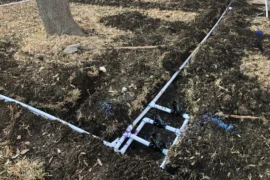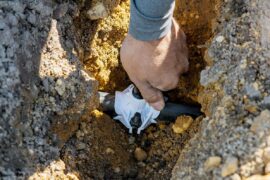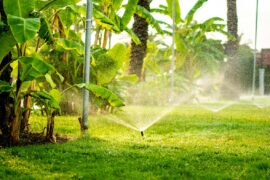Are you wondering why your sprinkler head isn’t spraying optimally? Let’s explore what can be done to resolve this pesky problem.
Dirt Build-Up and Clogs
1. Why does the sprinkler head struggle to send water to the expected radius? There might be small blockages hidden inside its nozzle opening. Small grains of soil deposited inside the nozzle can hamper the water flow. Raise the head to loosen the debris.
2. You may find muddy residues sitting within the irrigation line, affecting water flow. Sediments and lumps of sand could also be stuck inside. To remove the grime, dip a brush into a mild cleaner and use it to loosen and remove the dirt.
3. Do not overlook the residual gunk inside the spray nozzle. When spray routes are clogged, they slow down water flow, resulting in an inadequate performance. Remove the lingering clogs, and the rotor head will spin properly. Clearing the messes early will help keep your lawn lush and in good shape.
Inadequate Water Pressure
1. When there is weak water pressure, you should not blame the sun. The aging PVC pipes are the culprits, preventing your sprinkler head from performing optimally. Leaking pipes lead to gardens not getting enough water and wasting it unnecessarily. To ensure the entire lawn or garden gets enough water, check the pipes for leaks and cracks. Call a plumber if you cannot manage it yourself.
2. If the spray heads underperform and water a small area, check for the hidden leaks. These are often the reason behind the absence of strong water bursts. You may have to replace aging garden hose fittings. Doing so will improve water pressure.
3. What makes the once-powerful sprinkler system operate with hiccups? The issue might be a clogged filter or older fittings. Swap connectors, tighten nuts, and secure hoses to restore a robust water flow.
Misaligned Nozzles and Poor Positioning
1. There can be nozzles pointing downward, which will drain the soil instead of spraying outward. Adjust the direction to see how far the water reaches. Occasionally, plant leaves or grass blades may block the heads. Angle the heads or move them slightly for better water flow.
2. Do you notice an erratic spray pattern leaving some patches dry? Rotating the sprinkler head can help resolve this issue and reduce puddles in the lawn.
3. Sometimes, poor positioning can affect your garden watering efforts. If the rotor head is close to the edge, water may overshoot the desired area. With a little realignment, the turf will receive more water.
Broken Components and Exhausted Parts
1. Broken gears stuck inside the sprinkler system might reduce water distance. Faulty springs and cracked housing can slow down the spray. Replace the old parts to improve water flow. Once renovated, the sprinkler head will keep your lawn fresh and lush for years.
2. The PVC pipes may have tiny fractures that are not visible externally. Inspect these hidden flaws, as they may cause soggy puddles and weaker streams. Check the seals, washers and connectors for small leaks. Fixing these leaks will make your sprinkler work like new.
3. Over time, all components wear out, including the nozzle and internal parts! Invest in high -quality replacements for optimal lawn watering. Addressing minor damages promptly ensures your sprinkler set remains durable and efficient.





